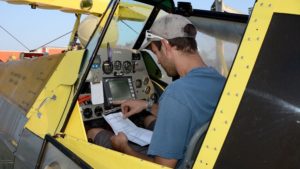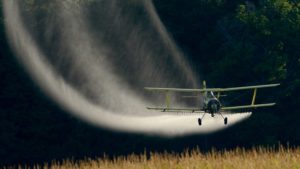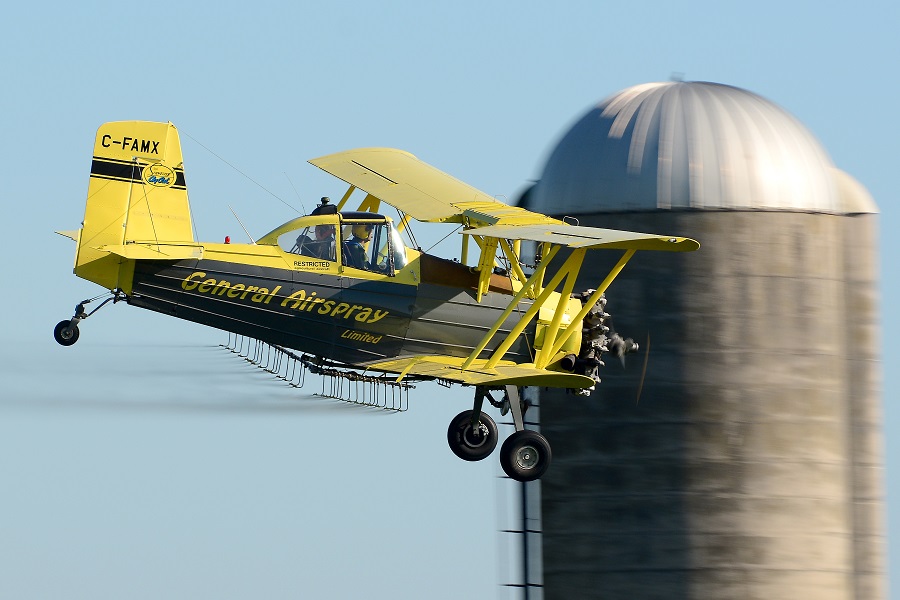Flying low
For General Airspray of Lucan, agricultural spraying is both a business and a way of life
Photos: Eric Dumigan Photography
JUST AFTER SUNRISE on a foggy, humid day in the marrow of the summer growing season, David Hodgins touched down at a rural airport near Walkerton in a white Piper PA-18 Super Cub monoplane and launched into the yeoman’s work of an agricultural pilot.
Click here to read this article in magazine format
Dressed casually, with clear safety goggles and a faded ball cap, Hodgins rapidly filled the holding tanks of two Grumman G-164 Ag-Cat biplanes with diluted fungicide and sent them back into the air to spray nearby cornfields.
“The early hours are not for everyone,” says Hodgins, a pilot and aircraft mechanic with General Airspray Ltd. of Lucan, one of the top agricultural spraying companies in Ontario.
Story Continues Below
“Getting up in the morning and then working till dark and then getting up again in the morning can be pretty strenuous. You kind of get used to it, I guess.”
Hodgins is the third generation of his family to staff General Airspray, located on a small rural compound near Lucan with three aircraft hangars and its own 3,000-foot grass landing strip.
David’s father, Paul Hodgins, owns and manages the company, started in 1962 by the late Roscoe Hodgins — David’s grandfather — and business partner, Doug Worgan.
General Airspray formed when Roscoe Hodgins and Worgan bought a portion of Leavens Brothers, a Toronto-based company later known as Leavens Aviation. They acquired four Boeing-Stearman Model 75 biplanes and operated an agricultural spraying business from St. Thomas Municipal Airport until 1971, then moved to a family farm near Lucan later that year.
 David Hodgins of Lucan-based General Airspray
David Hodgins of Lucan-based General Airspray
Today, General Airspray has agricultural clients across Southern Ontario, covering thousands of acres of crops with fungicide each summer. The company also plants about 2,000 acres of cover crops each year to replenish the soil with nitrogen and to prevent erosion.
Aerial spraying is a way of protecting the investment farmers put into their fields each spring, helping them avoid yield loss believed to be caused by soil compaction and crop trampling when tractors tow ground sprayers through the fields.
“When we put the fungicide on, the main thing is plant health,” says Paul Hodgins. “It keeps the plant greener longer, and it’s a stronger plant to stand through the fall.”
Aerial spraying is also more efficient than spraying with a land vehicle, but in lean years it’s an expense some farmers choose to avoid. That’s one of the key challenges.
Story Continues Below
“We’re at the whim of the commodity prices … as far as the agricultural work,” continues Hodgins.
In the fall and winter, General Airspray shifts its focus to aerial tree planting in Northern Ontario, Quebec, Saskatchewan and New Brunswick. Small, single-engine Super Cub aircraft carry 80-kilogram Brohm tanks that drop thousands of seeds onto harvested and fire-ravaged woodlots.
The company began its seeding work in the late 1960s and has seeded nearly 1.5 million acres since then, at a rate of about 12 acres per minute. Three seasonal pilots and three full-time employees pull together to ensure the operation proceeds without a hitch.

In the summer, Hodgins typically begins his day at 4 a.m. and finishes late in the evening. He’ll fly several hours to a job, fill and refill the venerable Ag-Cat sprayers with fungicide, fly home and repeat the process the next day.
He grew up around this kind of work and fell in love with it. Like many pilots, he can’t imagine a better office than the cockpit of a plane.
“It’s kind of always been in my blood,” he says. “I’m more of a morning person, so I don’t mind getting up.” ![]() Ben Forrest
Ben Forrest

